The Samsung Galaxy S7 & S7 Edge Review, Part 1
by Joshua Ho on March 8, 2016 9:00 AM ESTSoC Performance
While we’re ready to move on to newer benchmarks for 2016, our system performance benchmarks from 2015 are still going to provide a pretty good idea for what to expect from the Galaxy S7 and Snapdragon 820 by extension. For those that are unfamiliar with what the Snapdragon 820 is, I’d reference our previous articles on the Snapdragon 820.
In essence, we’re looking at a 2x2 CPU configuration with 2.15 GHz Kryo cores for the performance cluster, and 1.6 GHz Kryo cores for the efficiency cluster. Binding the two clusters together are some power aware scheduling at the kernel level and a custom interconnect to handle coherency between the two clusters. Memory is also improved relative to the Snapdragon 810, with a bump to LPDDR4-1866 over the former's LPDDR4-1600. Of course, there's a lot more to talk about here, but for now we can simply look at how the Snapdragon 820 compares in our benchmarks.
Update: As we've had a few questions on the subject, I just want to clarify browser testing. Samsung's stock browser was not included with our Verizon-branded sample phone, nor is it possible to install it at this time. As a result we are unable to test the performance of Samsung's browser. The Verge reports that this is a Verizon decision and that all Verizon phones will be shipping like this; so for these phones Chrome is the de-facto stock browser.
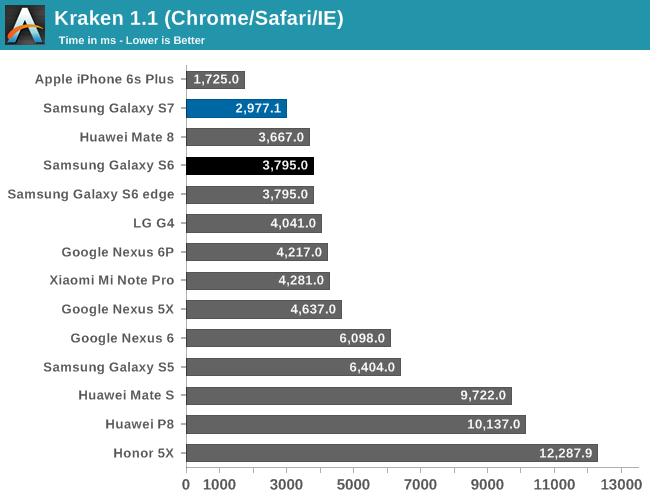

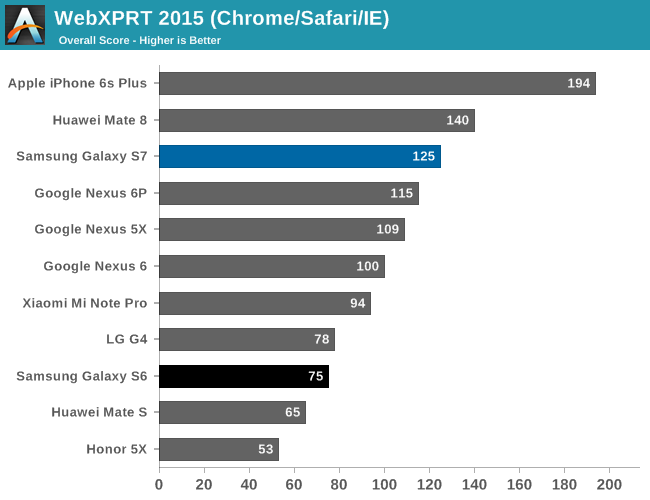
Starting off with our web benchmarks, we can see that in the time since our initial testing of the Snapdragon 820 MDP there have been some major improvements to how well Chrome is optimized for Kryo. As a result we're seeing results that are almost comparable to Snapdragon Browser in Chrome.
Overall then the Galaxy S7 and its Snapdragon 820 SoC won't top the charts on web benchmarks - Apple still holds an edge here - however the Galaxy S7 puts up a solid fight. The one drawback here is that the Mate 8 and its Cortex A72 CPU seems to have the edge over the Galaxy S7.
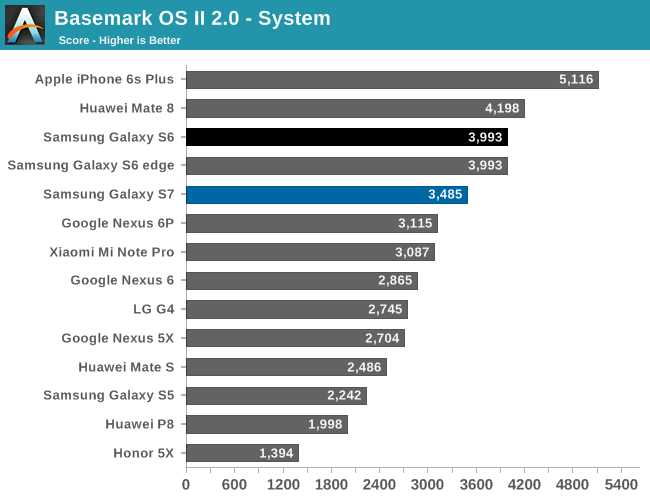
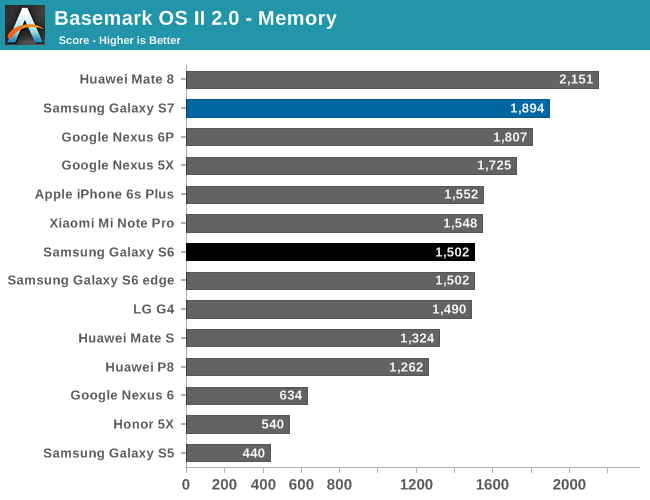
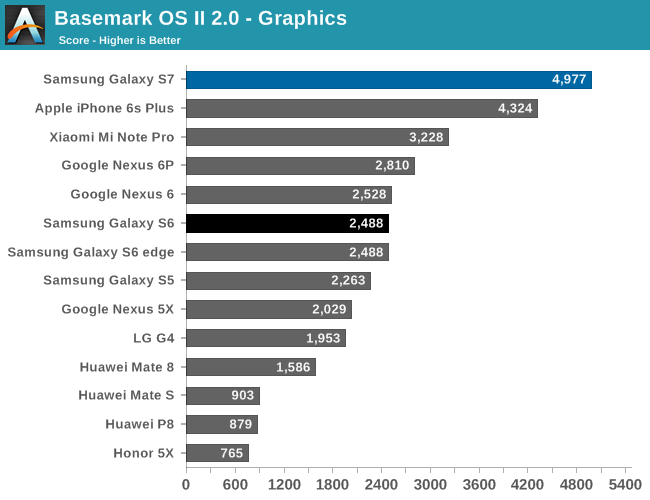
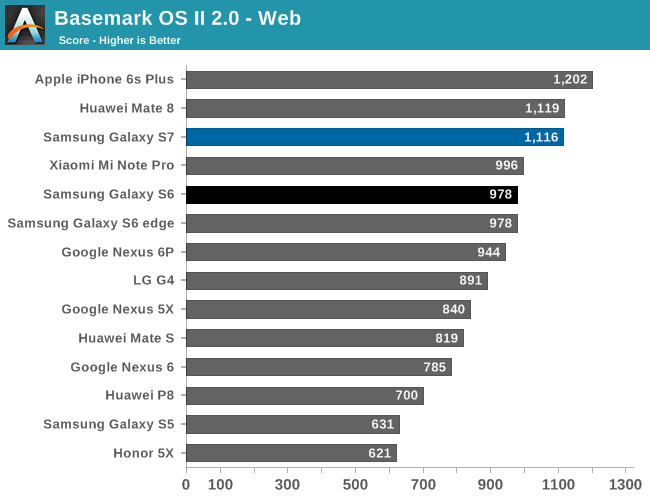
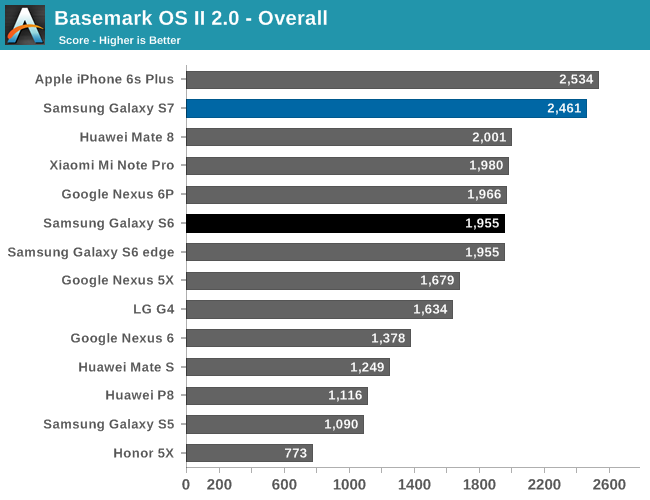
In Basemark OS II the combination of a better GPU, better NAND, and better single thread CPU performance seems to be enough for the Galaxy S7 to approach the iPhone 6s Plus in overall performance. While the system benchmark shows that Kryo isn't quite going toe to toe with Twister, the Adreno 530 helps to narrow the gap in the graphics test.
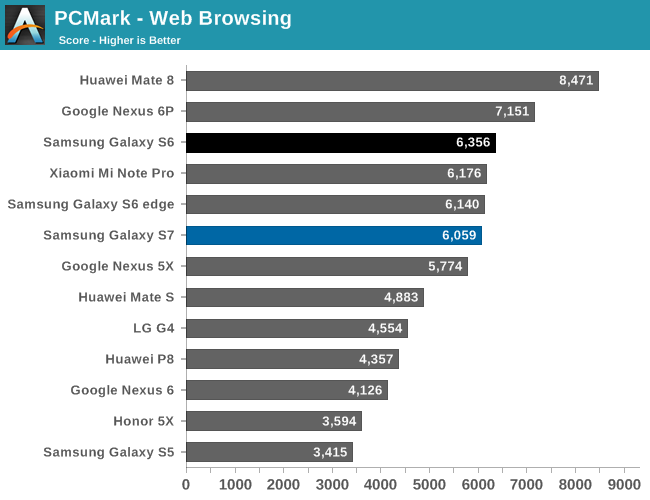
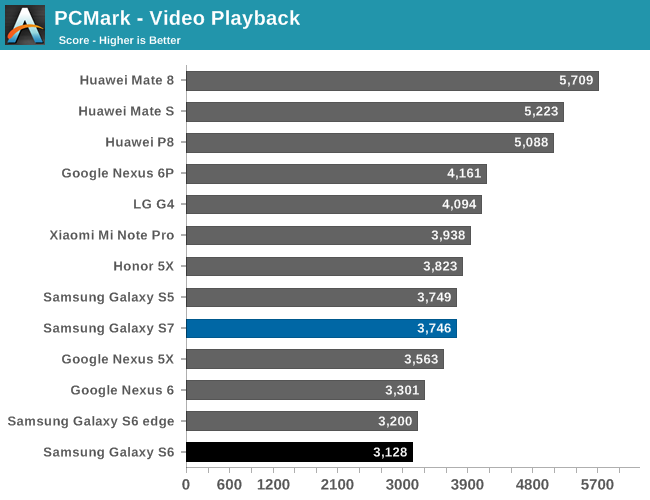


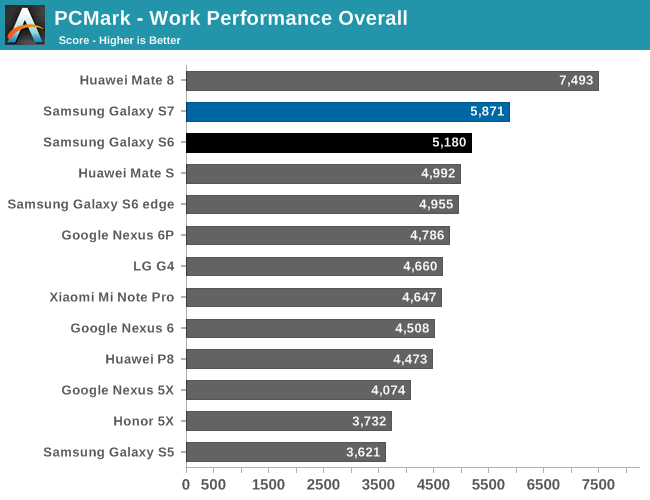
In PCMark, we can see that the Galaxy S7 is mostly comparable to the Galaxy S6. However major improvements in areas like GPU performance help to give it an overall advantage relative to the Galaxy S6 in the photo editing test. Given that this is basically a test of API-level performance, it's likely that Samsung's frameworks and governor settings lead to mostly similar performance in these tests.
Overall, the Snapdragon 820 appears to provide a pretty healthy bump in performance over almost every SoC seen in 2015, although it's hard to declare a clear winner when comparing it to Apple's A9 or Huawei's Kirin 950. If you glanced at the battery life graphs and the performance graphs above it's pretty obvious that Qualcomm has made some enormous strides here. While not quite going from zero to hero, Qualcomm has come close, and that definitely deserves some credit.
NAND Performance
If you think about the memory hierarchy, while RAM and cache are important, at the end of the day the most important aspect is the base storage. Even if you have infinite RAM and cache, if your storage is sufficiently slow the user experience is going to be painful for at least the first time you have to load something.
In order to test this, we use our standard test of AndroBench with 4 KB and 256 KB reads and writes for random and sequential tests. I went ahead and did some digging around to figure out exactly what it is we’re testing in the Galaxy S7, and it turns out that while the Galaxy S7 storage solution is similar to what’s in the Galaxy S6 and S6 edge, it isn’t quite the same. The Galaxy S7 UFS storage identifies itself as the KLUBG4G1CE-B0B1, which looks to be in the same family and appears to have been released at pretty much the same time as the Galaxy S6 storage solution, but the model number isn’t quite the same.
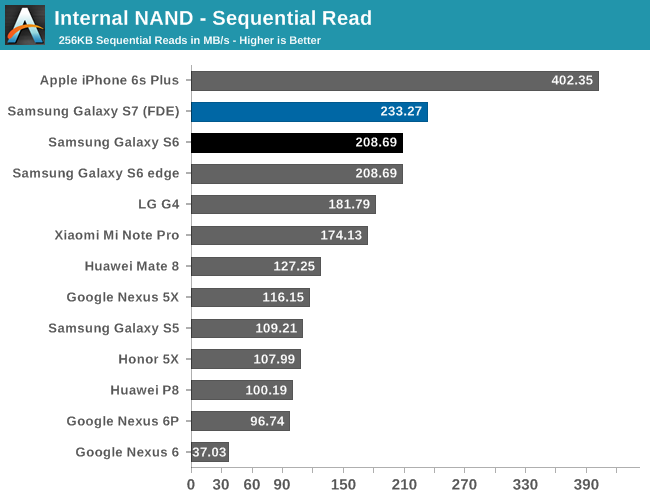
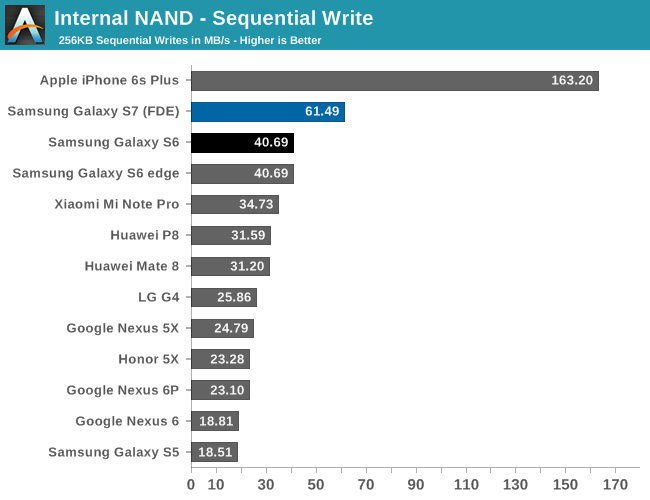
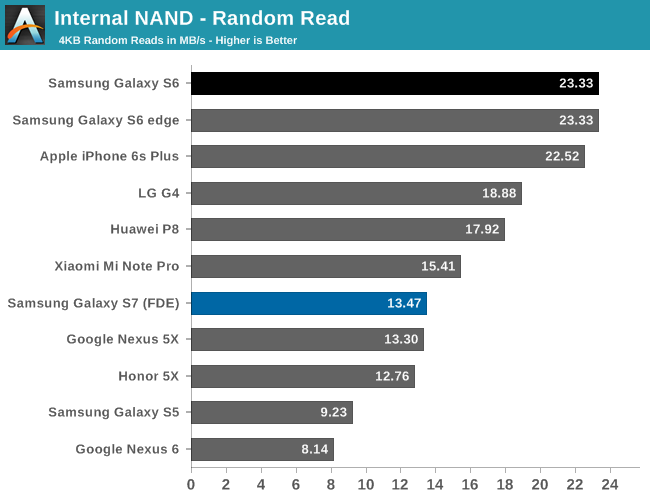
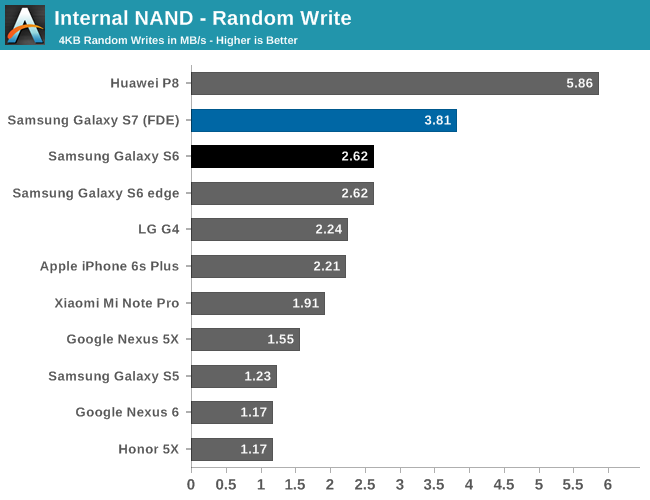
Looking at the performance results, we can also see that the Galaxy S7 is pretty similar to the Galaxy S6 in storage performance at a high level. Interestingly enough despite using full disk encryption on the Galaxy S7, we don’t really see a noticeable degradation in performance relative to the Galaxy S6 which is good to see considering the number of Android devices that do have noticeable performance effects when enabling FDE.










202 Comments
View All Comments
sachouba - Tuesday, March 8, 2016 - link
Thanks for this review, it's quite good.But I don't understand why the brightness would have been lowered whereas other websites tell the contrary - and Samsung usually increases the maximum brightness on every flagship device.
Moreover, the web battery life test is not representative of actual battery life, because AMOLED displays are very disadvantaged in this test on white web pages, whereas the battery life would be much higher on websites with a lot of dark areas (photos, dark background, etc.).
Some browsers allow you to use a "night mode" which inverts the colors of websites background if the APL is high.
I hope you will review the Exynos version as well - I guess it will be much smoother and with a better battery life, as always.
JoshHo - Wednesday, March 9, 2016 - link
Our new web test has some pages with dark themes currently. However, the overwhelming majority of webpages and UI have a high average picture level. In order to reflect this the vast majority of our webpages are black text on a white background.We are hoping to get an Exynos unit to compare with the Snapdragon 820.
lilmoe - Wednesday, March 9, 2016 - link
Please use the stock browser with Ad block enabled for that test on the Exynos variant. Thanks.deskjob - Tuesday, March 8, 2016 - link
I am totally for prioritizing energy efficiency and battery life over a 100% fluid UI. But I also find it hard to believe that at this stage in the smartphone evolution, a flagship device still can't achieve that goal without adverse effect on battery life. I feel like in the S7's case, it's more likely than not that Samsung and their proprietary UI is at fault for the janky UI performance. Would love it if you guys have time to investigate this further! After all, I am not sure I am not alone in saying a smooth UI is a big part of the everyday smartphone experience.heartinpiece - Tuesday, March 8, 2016 - link
Wow Finally!Will you be reviewing the Exynos 8990 as well?
Seems like a comparison between the 820 and the 8990 would be interesting!
10basetom - Tuesday, March 8, 2016 - link
I can't wait for a detailed comparison between the Snapdragon 820 and Exynos 8890 once you have both S7 models in hand.SydneyBlue120d - Wednesday, March 9, 2016 - link
Same old question, maybe in part 2 of the review we can get an answer: Is unlimited HEVC encoding at 2160p60 with both HDR and IOS supported? Thanks a lot.Osamede - Wednesday, March 9, 2016 - link
While its always interesting to see proper deep dive reviews, I find that these days there is nothing that would get me to buy another Samsung "flagship". Totally overpriced by strategically riding the slipstream of Apple's own boundless greed - except these ones do not hold value at all.s.yu - Friday, March 11, 2016 - link
You must be blind, choosing the recent iCrap over this. Apple's last good looking phone was the 5th generation.pjcamp - Wednesday, March 9, 2016 - link
You say people will find the stock Android interface "rather spartan." That strikes me as odd since I went from TouchWiz to an essentially stock Android on a Moto X Pure. I would never go back. Settings are located where they should be, not moved around at random. Customization is much easier. And stability is no longer an issue. I had, for instance, one major audiobook app that reliably crashed the system under TouchWiz to the point of needing a battery removal to get it restarted. I came to understand that TouchWiz, not the app, was the point of failure during the brief time I used Cyanogenmod and it worked fine. Also works fine on my Motorola.TouchWiz and other skins are not about operability. They are exercises in branding, equivalent to logos. Rather than being nonspartan, they are actually an impediment to usability. If you go to Google to find out how to do something, the instructions will be different from how your skinned phone operates. Sometimes it is easy to translate, sometimes not.
For a lot of people, that probably doesn't matter. But for a lot of people, introducing a skin introduces another potential point of failure, and another opportunity for vendors to point at each other in a circle should there ever be a problem.